Greek Folk Instruments: Chordophones, Aerophones, and Membranophones
This page consists of pictures and information on various Greek folk instruments. For more information about how the various instruments are used together in various regional styles, please visit my page on Greek folk instrument groups.
The Three General Families
Click on the jumplinks in the table below for more information on each particular instrument.
Stringed Instruments (Chordophones): |
Wind Instruments (Aerophones): |
Drum Instruments (Membranophones): |
Stringed Instruments (Chordophones)
Lyra Pontos
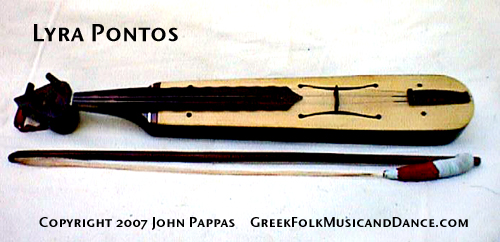
Pontian Lyra from Thessaloniki, 1970.
The LYRA of the Greeks of Pontos (Black Sea region of Asia Minor) is also known as the Kementse. It is played like a violin (violi) with a primitive style bow, but the musicians hold the lyra in an upright position. Sometimes they rest the instrument on their knee when they are sitting, and sometimes it is held out in front of them. They sometimes even dance in front of the dancers while holding the lyra in that way. The lyra usually has three strings. There are several tunings. Common tunings include: a-a-d, e-a-d, and many others. Since the instrument was often played alone, the tuning was often done according to the preference of the musician and his voice's range. Sometimes percussion instruments like a defi or daouli might be played to accompany the lyra. The musicians usually play two or all three strings at the same time, utilizing the open string(s) as a sort of drone to the melody. Sometimes they play the melody on two strings at once, giving a primitive harmony in fourths. They tend to play with many trills and embellishments, and with the unusual harmonies, the Pontian music has a very unique sound.
Lyra Crete
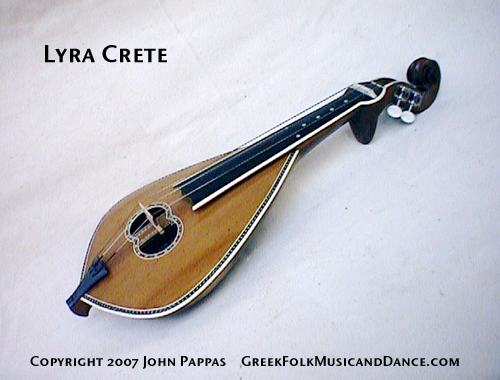
Cretan Lyra by M. Stagakis, 1981.
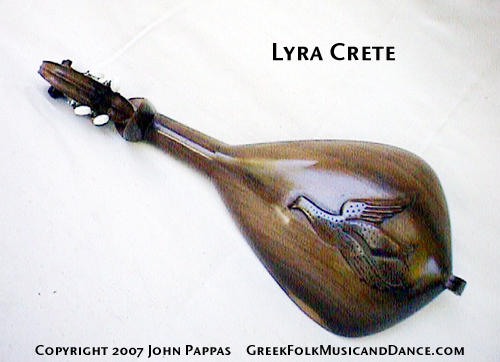
Carved Swallow; Back of Cretan Lyra by M. Stagakis, 1981.
The Cretan lyra is the most popular melody instrument on the island of Crete (Kriti). It is a bowed instrument similar to the violin (violi), and it usually has three strings which are tuned in fifths. The lyra players play the lyra in an upright position. They sometimes rest it on the kneee, or, if they are standing, they will put one foot up on a chair and rest the lyra on the thigh. They have an unusual way of fingering the strings. Instead of pressing the strings with the finger tips (like violinists or guitarists do), they press against the sides of the strings with the tops of their finger nails. Sometimes the lyra players play unaccompanied, and it was not uncommon for the bow to have small bells attached to lend a rhythmic accompaniment to the melodies as the lyratzis played his lyra. The most common instrument used to accompany the lyra is the Cretan laouto, which is typically larger than the mainland laouto and tuned lower. The Cretan laouto players often play melodies with the lyra rather then just chords and rhythm. Sometimes two laoutos accompany the lyra, with one playing melody and the other playing rhythm and chords.
Outi

Outi.
The outi (ud) is a stringed, lute type instrument that is used throughout the Arabic world. It originated with the Arabs. The Greek outi has mainly been used by the Greeks from Thrace and Asia Minor, which is now part of Turkey. When the Greek population was forcibly moved from their homelands in Asia Minor such as Smyrni (Izmir), Konstantinoupoli (Istanbul), and Kappadokia, musicians brought these instruments into mainland Greece. It is very popular in the music of Smyrna and the Poli, and is often played along with a violi (violin), a kanoni, and a hand drum like the toumbeleki. Sometimes it is played along with a klarino and a santouri also.
Baglamas

Baglamas; Peiraieus, circa 1950. Made by Kyriakos Lazaridis, once owned by Papaioannou.
The baglamas was often favored in the early part of the 20th century as a solo instrument for men in jail or for a small group of "rebetes" to play for singing and dancing. It is a smaller version of the bouzouki and is tuned re, la, re (D, A, D), but an octave higher than the bouzouki's tuning.
The baglamas can be used as a melody instrument and can be easily made from wood or other material for the back (including tortoise shells, gourds, or carved solid wood).
A saying that the old "rebetes" used to quote was: "Eho to baglamadaki, kato ap' to sakaki." "I have my baglamadaki under my coat." This refers to the fact that they would carry the small instrument tucked into the back of their belt, under the back of their coat tail so that it did not show. If they found the occasion to play for their own expression, or for some friends, they could take the baglama out. However, if the situation was not appropriate for a good "kefi" (mood), they could keep it out of sight.
It also has been used as a chord and rhythm instrument in small "bouzouki" bands. In this role, it is often played with a simple, driving rhythm giving a high pitched, insistent beat to back up the lead bouzouki. It thus rounds out the sound of the bouzouki band.
Tzouras
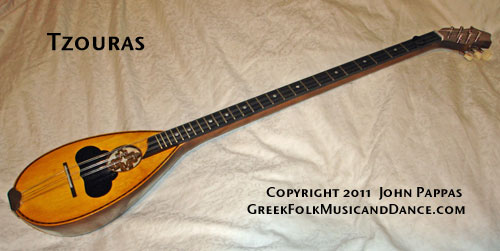
New Tzouras.
The tzouras is a long necked string instrument which is in the bouzouki family of instruments. The tzouras is also called a tambouras, and is similar to the ancient and Byzantine forms of the long necked stringed instruments. The body of the tzouras is smaller than that of a bouzouki.
In the past, the body of the tzouras was carved from a solid piece of wood, often mulberry wood, and they are still made this way today, although the body of the instrument is often made of separate staves (called "douyies" in Greek) just as the bouzouki is made.
Like the bouzouki and the baglamas, the tzouras (tambouras) was a favorite instrument of the rebetes in rebetiko music. For several years it was not as popular, but it has had a renaissance in the past few years. Almost all bouzouki luthiers now are making tzourades, and it is a very popular instrument today.
It is tuned exactly like the bouzouki, with three pairs of strings tuned D, A, D. It has a twangier sound than a bouzouki, but the style of playing is like old style bouzouki and lagouto playing, in that the musician periodically picks all the strings as a sort of drone as he plays the melody on the higher D string. Another similar instrument popular in Crete today is the boulgari, which is in the same tambouras family of instruments. It is played and tuned in the same way as the tzouras. And like the old lagouto and bouzouki/tambouras style of playing, old timers often used an eagle feather as a pick.
Finally, the tzouras and the baglamas make a great pair of instruments for old traditional rebetika songs.
Bouzouki
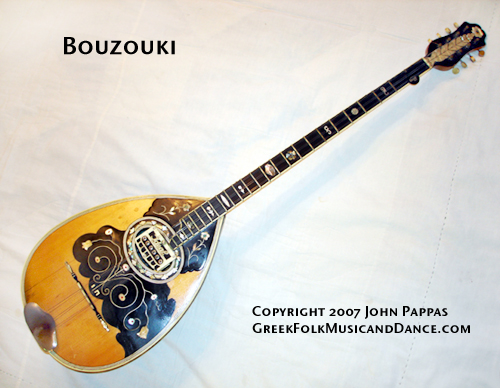
Bouzouki by Zozef, created for Papaioannou ca. 1940.
The bouzouki is the main or lead folk instrument found in the taverna style or rebetiki music of the seaports and urban areas of Greece. The bouzouki is the descendent of ancient Greek and eastern instruments. In ancient times the name of this long-necked string instrument was the "trichordo" or "three stringed instrument." During the Byzantine period, it had many names including "tambouras," "yiongari," "pantouri," and others. It has three pairs of strings tuned re, la, re (D, A, D). In the 1950's, a bouzouki with four pairs of strings tuned to the intervals of the high four strings of the guitar was developed. It is tuned down one key from the guitar's tuning to (C, F, A, D).
The make up of the typical bouzouki musical group has varied and changed over the years and has included many types of instrument groupings. A very common musical group might be one or two bouzoukia, a baglamas, and a kithara (guitar). Sometimes a violin, or an accordion, a piano, or other instruments would be played as well. Similar instruments that are played like the bouzouki in this style of music are the tzouras (long necked, like the bouzouki, but with a smaller body), and the baglamas (a very small bouzouki).
Santouri
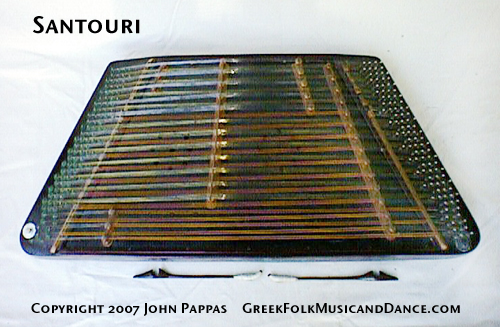
Santouri by A. Garavelis; Athens, 1981.
The Santouri is a type of hammered dulcimer. It probably evolved from harp-like instruments such as the lyra of the ancient Greeks. It is a form of the psalterion of Byzantine times, and some ethnomusicologists attribute the name, santouri, to the word psalterion. It is played with two "hammer-like" sticks whose ends are wrapped in cotten. These hammers are similar in function to the small hammers which strike the strings of a piano. The piano probably evolved from these early hammered dulcimer type instruments. The santouri tuning tends to be chromatic, and this works will with the Greek modes. Another tuning used is the "tsimbalon" tuning which was popularized in Hungarian and Romanian hammered dulcimers. The Santouri is popular with both the mainland "koumbania" which might include klarino, violi, lavouto and santouri, and the island folk group which might include a violi, lavouto, and santouri. The percussive sound of the Santouri lends a strong, rhythmic element to the group, but it also plays the melodies and chordal accompaniments.
Lavouto
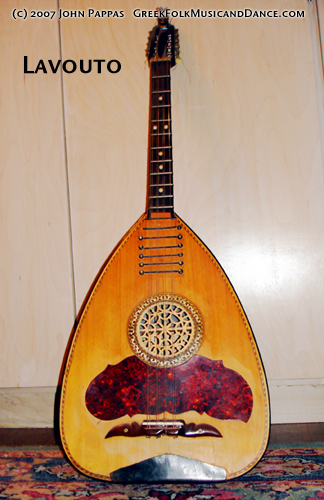
Lavouto by Kopeliadis, ca. 1930.
The lavouto (laouto, lagouto) is a stringed instrument in the lute family. It is related to the Arabic ud or the Greek outi, as well as to the European lutes. In Greek folk music, it is the largest plucked string instrument, followed by the tambouras/bouzouki, the tzouras, and the baglamas, from largest to smallest.
This instrument has 4 courses of strings, or four double strings. It is tuned (from lowest to highest strings) C, G, D, A. The lower three pairs of strings consist of one wound, heavy metal string, and one unwound string. The highest strings, the A, consists of a pair of unwound strings of the same diameter.
There are three sizes of lavouta. The largest is found on the island of Crete, and it is often tuned lower than the tuning found in other parts of Greece. The medium size is the most common and is found all over Greece. There is also a slightly smaller size which is not as common. It is very good for playing melody along with the lead melody instruments.
The lavouto is used in most regions of Greece, including the mainland and the islands. It can be used as a melody instrument or as a chord, rhythm instrument to accompany a melody instrument such as the klarino or violi. Sometimes the lavouto players will strum the rhythm by striking all of the strings while playing the melody on the higher strings. This gives a melody, as well as a drone harmony and a dance rhythm. Today, in the folk music of mainland Greece, most lavouto players play chords and rhythm, while on the island of Crete, the lavouto players play melodies as they accompany the lead instrument, the lyra.
Lavoutokithara

Lavoutokithara by "O Larisaos" Antonis Theodorou.
The lavoutokithara is a sort of hybrid instrument. It is basically a guitar-shaped body with lavouto strings and tuning. On the older lavoutokithares, many lavouto elements are present which are different from those of a guitar.
There are 8 tuning keys, and they have 4 courses of double strings tuned to C, G, D, A, just like the regular lute-like lavouto. The fingerboard is even with the face of the instrument. Instead of having metal frets, the nylon line "berdedes" are tied on around the neck, just as they are on the regular lavouto.
The reason for making this instrument is said to be caused by the introduction and growing popularity of the guitar in the Greek urban music. So lavouto players, wanting to look like they were playing the modern guitar, had the luthiers make lavouta that looked like guitars but that were tuned exactly like their traditional lavoutos. This development occurred sometime around the 1940's or 1950's.
Wind Instruments (Aerophones)
Floyera, Tzamara, and Gavali
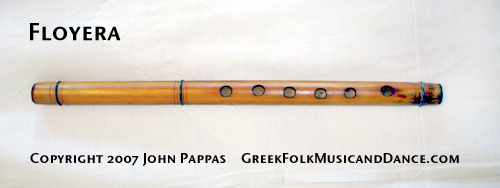
Floyera made by John in Kyparissia.

Tzamara Metsovon.
The floyera is the Greek shepherd's flute. It is not a "whistle" type flute where the musician puts the flute into his mouth and blows like blowing a whistle. Instead, the musican blows across the open end or rim of the upper part of the floyera. In most areas of mainland Greece including Roumeli and Peloponnisos, the instrument is called the floyera.
It can vary in length, but commonly the flolyera is about 12 inches long, more or less. In northern Greece they also have longer floyeres. In Epiros, northwestern Greece, these longer flutes are called tzamara. In Greek Thrace, northeastern Greece, they are sometimes called gavali (similar to the Bulgarian kaval). These longer flutes are usually around thirty (30) inches or so in length. The longer tzamara or gavali flutes have a different fingering and allow for playing half tones more easily that on the shorter floyera.
Shepherds often play these, as they are fairly easily made by the musician himself. They can be made from bamboo, or from a straight branch from a tree which has a pithy center that can be poked out easily. Sometimes, the shepherds would make the floyera from the bone of a large bird's wing (like the eagle's wing bone). These floyeres were said to have magical properties. The finger holes, usually six (6) on the top and one (on the bottom), but sometimes seven (7) on the top, could be burned into the bamboo or wood or bone body of the floyera. A piece of wire or metal the proper diameter would be heated to red hot in a fire and then the finger hole would be burned through. Sometimes, pieces of metal pipe would be used, and the shepherd would have a metal worker drill the finger holes to his satisfaction. I have even made floyeres myself from pvc or plastic pipe, and they play quite well.
If you are interested in purchasing a handmade floyera or tzamara, please visit my "For Sale" page.
Karamoudza
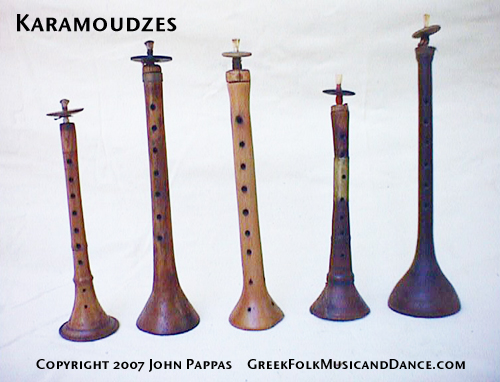
Karamoudzes.
Before the klarino arrived in Greece (approximately 1830), the main instruments in the mainland of Greece were the double reed Karamoudzes and the Daouli drums. Variations of these instruments could be found in most regions from the north all the way to the south, and even on some of the islands.
The Karamoudza is similar to the ancient Greek Avlos, which was also a double reed instrument. Drawings from ancient Greek vases show that musicians usually used some sort of a "lip guard" which helped them keep their lips from losing air as they played. Today, karamoudza players use the "kareli" or small wooden disk for the same purpose. Other names for the Karamoudza include: pipiza, zournadi, and zournas. They range in size from the small, approximately 5 or 6 inch zournadi to the large approximately 20 inch long zournas common in Greek Makedonia. In Peloponnisos and Roumeli, the pipizes or karamoudzes are usually about 12 inches long.
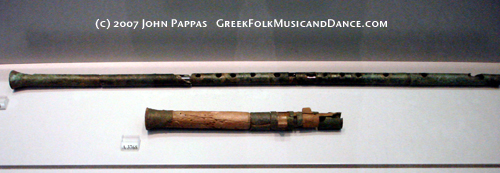
Very old "flutes": Bone avloi (or auloi). Avloi were double-piped reed instruments played in ancient times.

An ancient statue featuring an avlos player. Avlos players would play to help athletes keep time while competing in the halma (or "long jump") event in the ancient panhellenic games.
Thiambioli Crete
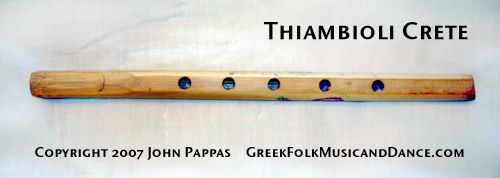
A Cretan Thiambioli.
The thiambioli is a very primitive clarinet type instrument. It is a single reed wind instrument played by shepherds, especially in Crete (Kriti). It is made from a piece of cane (like bamboo). One end is left closed, where the joint would be, and then a slice is made so that a thin "reed" is formed which can vibrate when that end is blown. (One can see how similar this is to the reed which is attached to a mouthpiece on a clarinet.) Then some holes are cut or burned into the instrument as finger holes. The bottom end is open. The thiambioli would seem to be a forerunner of the bagpipes and the early clarinets like the chalumeau.
Tsabouna Crete
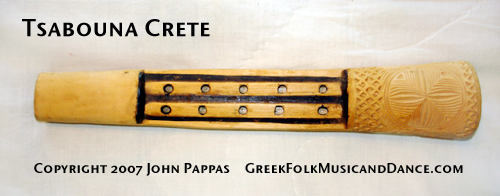
A Cretan Tsabouna.
The tsabouna is the same as the bagpipe tsabouna from the Greek islands (see below), and similar to the Pontian bagpipe, askavlos. Sometimes the bagpipe type instrument is called askomantoura. However, sometimes the part that the player plays with his fingers is not attached to a bag, as is the case with this example. This "chanter" can be placed directly in the mouth and blown this way. Sometimes there is a bulbous mouthpiece place between the reed part. It acts as a sort of air reservoir. We can see that the reeds are made the same as the reed of the thiambioli, but the cylinder with the finger holes is made separately and can be much more sophisticated than the thiambioli. In fact, the reeds for the mainland gaida (bagpipe) are made in the same way.
Tsabouna Kythnos
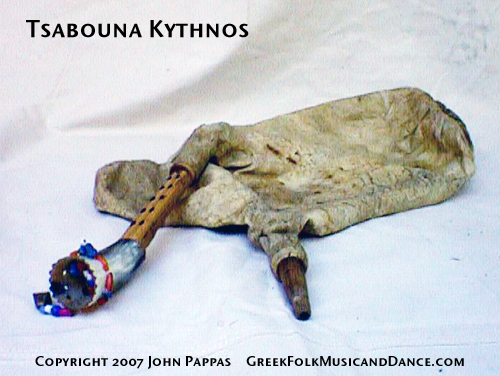
Tsabouna from Kythnos; circa 1976.
The Tsabouna is a type of bagpipe which is very popular on many of the Greek islands. It differs from the mainland bagpipe (or gaida) in that it does not have a separate, low-toned drone pipe. Instead, the Tsabouna has double pipes that are fingered at the same time. In other words, the musician plays two pipes at the same time. On some islands one of the pipes has 5 holes, while the other one has only two. This gives a simple "moving drone" sound. On this bagpipe from Kythnos, both pipes have the same number of holes, and the result is a melody which is played in unison on two pipes at the same time. The interesting thing is that the two pipes are usually somewhat out of tune with one another, and this gives a very interesting sound. The Tsabouna on Kythnos is usually played by shepherds and it is accompanied by the small drum, the toumbi. Sometimes a laouto will play a simple open chord, rhythmic accompaniment to the Tsabouna.
Gaida Kavala

Gaida from Kavala; circa 1975.
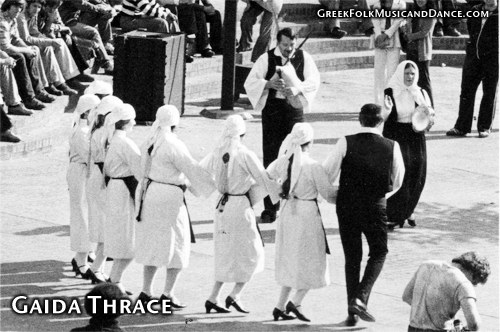
John plays a Thracian gaida at San Joaquin Delta College's 1977 campus dedication event. The Delta Hellenic Dancers perform to the music.
The Greek gaida is similar to other bagpipes found in Balkan countries. According to Anthony Baines, the bagpipe has been used by the Greeks since ancient times. The gaida has a single chanter pipe and one drone pipe. The reeds are single (like a clarinet reed). Gaides like this one can be found today mostly in northern Greece, including Greek Macedonia and Thrace. At one time it was found even in southern Greece. According to my grandmother, Kaliopi Petimeza Pappayiorga, she remembers the gaida when she was young (circa 1890's) in Arkadia (Peloponnisos). She pronounced the name as "gazhda." The gaida can be played unaccompanied, but percussion instruments are played when another musician is available. The favorite accompaniment for the gaida varies. In Greek Macedonia the daouli or toumbano (large drum) accompanies the gaida. In Greek Thrace, the defi or daires (small hand drum like a tambourine) accompanies the gaida.
Klarino
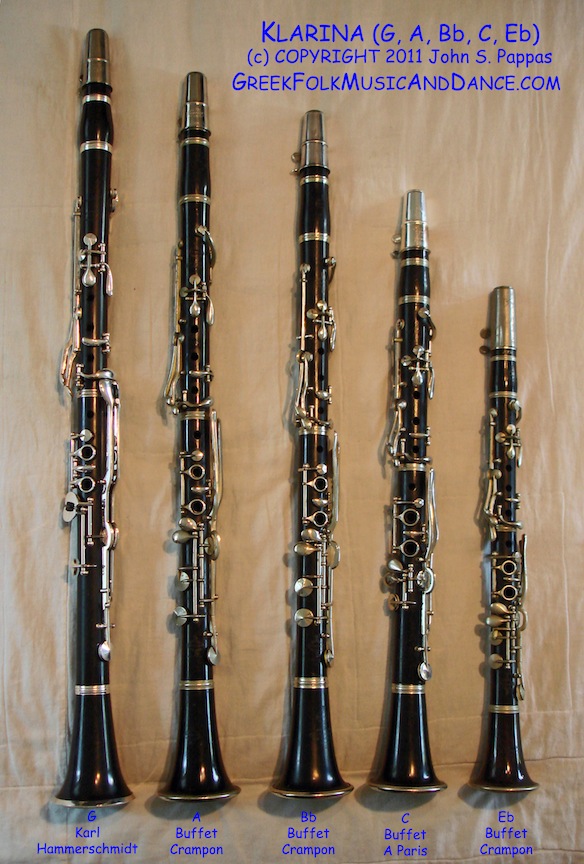
Five Albert System klarina: Keys of G, A, B flat, C, E flat.
Klarino is what the Greeks call the Greek clarinet, and it is the most popular lead melody instrument in the mainland regions of Greece. It is an Albert (or simple) system clarinet which is an older, more primitive version of the clarinet now common in classical and popular music in most of Europe and America. The Albert system klarino has fewer keys and has a different tone than the modern clarinet. The Greek "klaritzides" also play the klarino with a different style and sound than that used by classical musicians in Europe and America. The klarino in the key of "C" ("do") is a favorite of the old folk klaritzides (clarinet players), although the Albert Bb has become the most popular clarinet in recent years. They also use the A and G clarinets, which are lower pitched instruments, for some music.
Drum Instruments (Membranophones)
Daouli
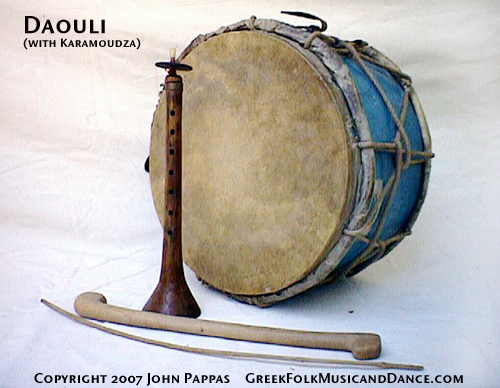
Daouli (shown with Karamoudza) from Zevgolateio, Korinthias.
The Daouli is the two headed drum. The daouli player usually hangs the drum from a belt or strap over his left shoulder. The right side of the drum has a lower pitched skin, while the left side has a higher pitched skin. Goatskins are Usually used for the drumheads. In my family's village of Kandyla, the tradition in the old days was to use wolf skin for the heads of the daouli. A friend from Epiros told me they used to use wolf skins for the defi (hand drum similar to a large tuned tambourine), and today they still favor dog skin.
The right or lower side is struck with the "daouloxylo" or daouli stick, and the left or higher pitched side is struck with the "daouloverga" or daouli switch. The main dance beats are played with the heavier stick on the right side, while the decorative and "in between" beats are played with the light stick. Other names for the daouli, depending on the area, include toumpano, tymbano, or toumbi. This is from the ancient Greek word tympano which exists in English in the word "tympani" for the drum section in the modern classical orchestra, and the tympanic membrane for the ear drum.
These drums vary in size from the small 12 to 14 inch diameter toumbi, to the 3 to 4 foot diameter daouli in the north of Greece. The most common size in Peloponnisos and Roumeli tends to be about 20 to 30 inches in diameter.
Defi
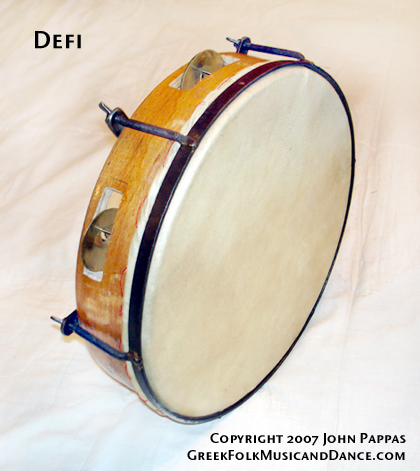
Defi from Epiros.
The defi (sometimes called daire in other areas) is a fairly large hand drum with metal bangles. It is similar to a tambourine in construction, however the defi is made with a metal screw system so that the head can be tightened and tuned. It is popular in many forms all over Greece, expecially in the mainland klarino music. The defi is particularly popular in Epiros in northwestern Greece, where they are still handmade today. They have a beautiful low tone, and the bangles are low pitched as well. A virtuoso defi player can decorate the rhythm of the songs in many exciting ways.
Toumbi
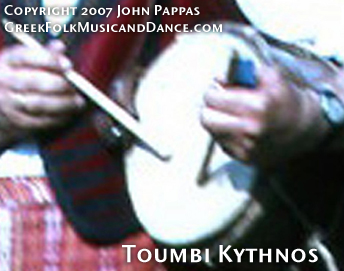
Toumbi Kythnos.
The toumbi is a very small drum made in a similar way to the daouli. It is mainly used on the Aegean islands like Kythnos. The toumbi is held usually under the left arm, and the head of the drum is struck with two drum sticks. It is often used to accompany the island tsabouna (bagpipe).
This page was last updated on 10/10/2024.
